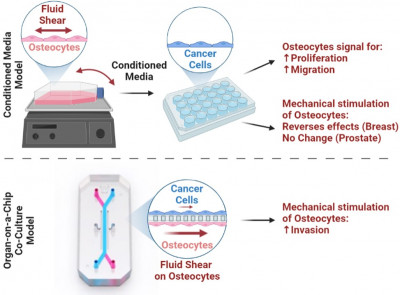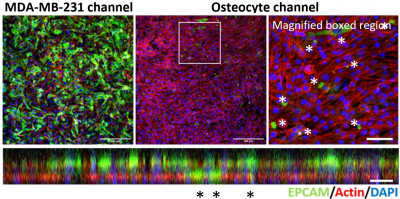News
New organ-on-a-chip study demonstrates how physical exercise regulates bone metastasis in breast and prostate cancer
17 June 2021


Bioengineers at Queen Mary publish a new study in the journal Cancers which demonstrates the significant impact of physiological mechanical loading on bone metastasis in breast and prostate cancer. The paper describes a new organ-chip model of bone metastasis which incorporates cancer cells and bone cells in a microfluidic organ-chip with mechanical stimulation to represent physiological loading of bone during normal excercise.
This new paper is the first to be published using the new Queen Mary + Emulate Organs-on-Chips Centre (cpm.qmul.ac.uk/emulate). The research was conducted by Dr Stefaan Verbruggen working in Prof Martin Knight’s group based in the Bioengineering Division at the School of Engineering and Materials Science at Queen Mary University of London. In collaboration with researchers at Columbia University, New York, and Dr Oliver Pearce's group at Barts Cancer Institute, Dr Verbruggen built a microfluidic organ-chip model of the tumour-bone microenvironment, finding increased invasion of cancer cells with mechanical stimulation. By understanding this mechanism, the research team hope to be able to develop new treatments for breast and prostate cancer bone metastasis which current has a very poor survival rate.
The study was funded by a Marie Sklodowska-Curie fellowship from the European Union’s Horizon 2020 Research and Innovation program, with additional support from a new EPSRC-CRUK Multidisciplinary Award held by Prof Knight and Dr Pearce. The organ-chip model is now being further developed by Dr Joanne Nolan as part of this EPSRC-CRUK grant. The research team will then investigate novel treatments for bone metastasis based on pharamaceutical manipulation of bone cells and their specialised signalling organelles known as 'primary cilia'.
| Contact: | Stefaan Verbruggen |
| Email: | s.verbruggen@qmul.ac.uk |
| Website: | |
| People: | Martin KNIGHT Stefaan VERBRUGGEN |
| Research Centre: | Bioengineering |
Updated by: Stefaan Verbruggen




